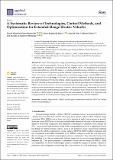| dc.contributor.author | Puma-Benavides, David Sebastian | |
| dc.contributor.author | Izquierdo-Reyes, Javier | |
| dc.contributor.author | Calderon-Najera, Juan de Dios | |
| dc.contributor.author | Ramirez-Mendoza, Ricardo A. | |
| dc.date.accessioned | 2022-01-21T13:47:59Z | |
| dc.date.available | 2021-10-28T12:50:37Z | |
| dc.date.available | 2022-01-21T13:47:59Z | |
| dc.date.issued | 2021-07 | |
| dc.date.submitted | 2021-07 | |
| dc.identifier.issn | 2076-3417 | |
| dc.identifier.uri | https://hdl.handle.net/1721.1/136685.2 | |
| dc.description.abstract | For smart cities using clean energy, optimal energy management has made the development of electric vehicles more popular. However, the fear of range anxiety—that a vehicle has insufficient range to reach its destination—is slowing down the adoption of EVs. The integration of an auxiliary power unit (APU) can extend the range of a vehicle, making them more attractive to consumers. The increased interest in optimizing electric vehicles is generating research around range extenders. These days, many systems and configurations of extended-range electric vehicles (EREVs) have been proposed to recover energy. However, it is necessary to summarize all those efforts made by researchers and industry to find the optimal solution regarding range extenders. This paper analyzes the most relevant technologies that recover energy, the current topologies and configurations of EREVs, and the state-of-the-art in control methods used to manage energy. The analysis presented mainly focuses on finding maximum fuel economy, reducing emissions, minimizing the system’s costs, and providing optimal driving performance. Our summary and evaluation of range extenders for electric vehicles seeks to guide researchers and automakers to generate new topologies and configurations for EVs with optimized range, improved functionality, and low emissions. | en_US |
| dc.publisher | Multidisciplinary Digital Publishing Institute | en_US |
| dc.relation.isversionof | http://dx.doi.org/10.3390/app11157095 | en_US |
| dc.rights | Creative Commons Attribution | en_US |
| dc.rights.uri | https://creativecommons.org/licenses/by/4.0/ | en_US |
| dc.source | Multidisciplinary Digital Publishing Institute | en_US |
| dc.title | A Systematic Review of Technologies, Control Methods, and Optimization for Extended-Range Electric Vehicles | en_US |
| dc.type | Article | en_US |
| dc.identifier.citation | Applied Sciences 11 (15): 7095 (2021) | en_US |
| dc.contributor.department | Massachusetts Institute of Technology. Microsystems Technology Laboratories | |
| dc.relation.journal | Applied Science | en_US |
| dc.eprint.version | Final published version | en_US |
| dc.type.uri | http://purl.org/eprint/type/JournalArticle | en_US |
| eprint.status | http://purl.org/eprint/status/PeerReviewed | en_US |
| dc.date.updated | 2021-08-06T15:19:37Z | |
| dspace.date.submission | 2021-08-06T15:19:37Z | |
| mit.journal.volume | 11 | en_US |
| mit.journal.issue | 15 | en_US |
| mit.license | PUBLISHER_CC | |
| mit.metadata.status | Authority Work Needed | en_US |
